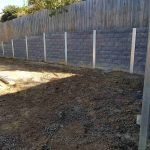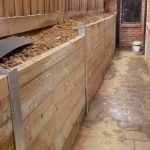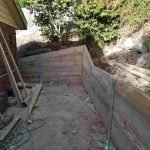Introduction
When it concerns landscaping and structural integrity, maintaining walls play a pivotal function. These engineered structures not only serve the practical function of avoiding soil disintegration however likewise include visual worth to your home. Whether you're wanting to boost the appeal of your garden or need a functional service for uneven terrain, understanding the nuances of retaining wall contractors is vital. Our objective here is to check out the multifaceted world of retaining wall construction, concentrating on products such as timber sleeper, concrete sleeper, and H-beam techniques utilized by professionals in the field.
Retaining Wall Builders: Crafting Stability and Beauty
Building a retaining wall is no http://edwinspecialistsddp880.trexgame.net/the-role-of-a-retaining-wall-contractor-more-than-simply-building little task; it requires cautious planning, specialist knowledge, and an eye for design. Retaining wall builders are proficient artisans who comprehend the science behind stability while guaranteeing that appeal isn't compromised. They work meticulously to choose the best materials and methods customized to meet each unique requirement.
Why Select Professional Retaining Wall Builders?
The concern emerges: why should you consider employing professional retaining wall home builders instead of taking on the project yourself?
- Expertise: Experts have comprehensive training and experience in constructing resilient keeping walls. Safety: A poorly constructed wall can lead to catastrophic failures. Professionals guarantee that walls are safe and certified with regional regulations. Aesthetics: Competent home builders know how to integrate walls into the landscape seamlessly, enhancing your home's visual appeal.
Understanding Various Types of Maintaining Walls
1. Gravity Walls
Gravity walls count on their weight to withstand lateral earth pressure. These walls can be made from various products including stone or concrete.
Advantages of Gravity Walls
- Simple design Cost-effective Naturally blends with landscape
2. Cantilevered Walls
Cantilevered walls use utilize; they are typically made from strengthened concrete and have a thick base that extends back into the soil.
Benefits of Cantilevered Walls
- Economical for taller structures Efficient use of material Can handle significant loads
3. Anchored Walls
Anchored keeping walls are secured by anchors that extend into steady soil or rock behind them.
Pros of Anchored Walls
- Suitable for steep slopes Added stability without large masses Flexible style options
Key Materials Used by Retaining Wall Builders
Timber Sleeper Retaining Walls
Timber sleepers have ended up being significantly popular due to their natural look and ease of installation.
Characteristics of Timber Sleepers
- Environmentally friendly Versatile in design Cost-effective compared to other materials
Considerations: While timber offers lots of benefits, it's vital to pick treated wood resistant to rot and pests.

Concrete Sleeper Retaining Walls
Concrete sleepers offer a robust alternative understood for their durability.
Features of Concrete Sleepers
- High strength-to-weight ratio Minimal maintenance required Resistant to weather conditions
Installation Tips: Correct drainage behind the wall is important to avoid water accumulation which could undermine its stability.
H-Beam Maintaining Walls
H-beams offer exceptional support thanks to their shape which enables them to distribute weight evenly.
Advantages of H-Beams
- Superior load-bearing capacity Durable versus environmental elements Quick setup process
Usage: Typically used in commercial applications due to their reliability and strength.
The Design Process for Keeping Walls
Site Assessment
Before any building begins, a detailed website evaluation should be performed. This includes taking a look at:

Planning & Style Phase
Once assessed, it's time for style-- this includes determining:
The height and length of the wall. Material selection (timber sleeper vs concrete sleeper). Aesthetic considerations.Construction Methods Utilized by Professionals
Excavation & Preparation
The primary step in developing a retaining wall is excavation-- guaranteeing that you have firm ground upon which your wall will sit is critical.
Remove topsoil. Level out the location appropriately. Create drainage channels if necessary.Foundation Work
A strong foundation assurances stability:
Lay down gravel for drainage. Set up formwork if using concrete. For lumber sleepers, establish anchor points in the ground.Installation Actions for Different Kinds Of Materials
Installing Timber Sleeper Walls
Measure and cut sleepers according to your design. Position them vertically or horizontally based on aesthetics. Secure them utilizing stakes or brackets for included strength.Installing Concrete Sleeper Walls
Mix concrete according to specifications. Pour concrete into forms set up during structure work. Allow appropriate curing time before using extra layers or finishes.Installing H-Beam Walls
Drive H-beams into pre-dug holes at specified intervals. Backfill around beams while preserving level alignment. Use additional supports if needed during construction phases.Drainage Solutions for Keeping Walls
Proper drainage is critical when developing any type of retaining wall as it helps prevent hydrostatic pressure accumulation which can cause failure over time.
Why Is Drain Important?
Hydrostatic pressure can weaken your structure leading it possibly collapsing under excess water weight; for this reason:
Incorporate weep holes throughout construction. Use drain pipelines behind the wall directing water far from foundation areas. Ensure correct grading around the base so water flows away from your structure effectively.Maintenance Tips for Lasting Retaining Walls
To keep your retaining walls looking excellent while functioning correctly:
Regularly check for fractures or bulging signs suggesting failure. Clean debris from weep holes periodically. Reapply treatments (for wood) every few years as essential depending on direct exposure conditions.FAQs about Retaining Wall Builders
Q1: Can I build my own retaining wall?
A: Yes, you can construct one yourself; however, working with specialists ensures security and compliance with local regulations while supplying proficiency in design and product selection.
Q2: For how long do timber sleeper walls last?
A: Treated timber sleeper walls can last anywhere from 15-- 30 years depending on ecological conditions and maintenance practices embraced over time.
Q3: What's more cost-effective - lumber or concrete sleepers?

Q4: Do I need a permit for my maintaining wall?
A: Depending on local guidelines regarding building and construction jobs, licenses might be required especially if going beyond specific heights; constantly contact local authorities.
Q5: Exist particular styles available?
A: Absolutely! There are numerous styles varying from rustic wood aesthetics through streamlined modern designs including stone or brick surfaces-- speaking with specialists typically yields customized solutions.
Q6: How do I understand what material is best suited?
A: Aspects such as budget restrictions, wanted aesthetic appeals, height requirements in addition to environmental considerations all contribute towards choosing ideal materials-- seeking advice from professionals can greatly assist this decision-making process!
Conclusion
In conclusion, building a robust yet lovely retaining wall is an endeavor that is worthy of attention covering both artistry along with engineering expertise-- retaining wall builders embody this balance skillfully! Whether going with timber sleeper services offering natural appeal or going robust with concrete sleep choices along with innovative methods like H-beams; engaging knowledgeable professionals makes sure success throughout all phases-- from initial planning through continuous upkeep strategies!
With this extensive guide covering different elements involved in producing strikingly stable landscape features we hope you feel much better equipped moving on! Embrace these insights supplied here today-- your outdoor area will thank you later!